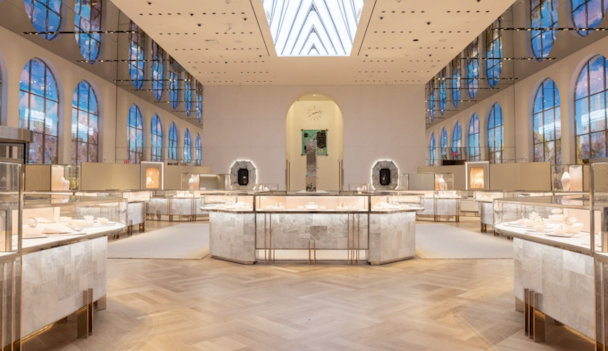I fell in love with Tiffany & Co’s new destination flagship – here’s why
Michelle Du-Prât, co-founder and chief strategy officer at design agency Household, recently visited the revamped Tiffany & Co Landmark store in New York, which she says is a lesson in how to do a modern flagship.

Tiffany & Co The Landmark on Fifth Avenue / Tiffany & Co
The ‘destination flagship’ is in its ascendancy again. You read it here first.
There’s been a radical makeover and recast of characters and genre fit for the next generation hungry for entertainment and connection. Brands are embracing this opportunity to reinvent the flagship model, crafting expansive in-store experiences that think ‘community’ beyond sale. From the Louis Vuitton x Yayoi Kusama flagship to the newly opened Tiffany & Co on Fifth Avenue, this rise in the flagship celebrates the return of physical spaces heralding a new agenda.
Tiffany & Co’s iconic legacy has provided the brand with a distinct yet fresh springboard to success. Fusing with the world of art and entertainment, the flagship is steeped in pop-culture history, making it a permanent fixture in the creative world. After four years in the making, the brand has birthed a new image directed at a new breed of audience ready to immerse.
Advertisement
Inside the four blue walls
The Fifth Avenue ‘flagship’ – dismissed as such by LMVH, in preferring the term ‘The Landmark’ – truly embodies the next-gen experience of placemaking that many brands crave but struggle to achieve. It has been done through unleashing emotion, cultural connections and the power of real-life experiences.
The essence of its success is by celebrating the heritage without simply trading on the past. It’s a ‘flagship that makes you feel’. You don’t expect to, but you can’t help falling head over heels. From the blue boxes in the street that build anticipation to the roped-off queue to ensure each person who enters is welcomed individually as a ‘VIP,’ it makes for the beginning of a unique love story.
The spectacle continues over 10 floors, with over 40 works of art from artists including Jean Michel Basquiat, Anish Kapoor and Julian Schnabel. A walk-in darkened booth loops footage from Breakfast at Tiffany’s with the soundtrack of Moon River and brush swipes of the iconic pale blue overlaying scaled archive images of Audrey Hepburn – elements that captivate the customer, turning them into fans as they walk in.
Advertisement
From flagship to landmark
Flagships are more than the sum of their parts. They are a seamless journey set to provoke, inspire and awe through easy and effortless interactions. They go deeper, and yes, at some point, drive spend. Our work with Warner Bros Discovery, on the first official Harry Potter Flagship in New York, proves flagships have transcended scaled-up retail into destination locations made with and for fostering fandom. They command commercial success through products and services only found in those locations, in turn ensuring a halo effect across the entire estate.
Luxury brands are further finding new ways for guests to spend time uniquely with them. Hermès’s new palatial Upper East Side mega flagship has divided its interior into a series of salons, with coffee, cocktail and champagne bars located on almost all floors and on-tap butler services at the ready for anything in between. This entices guests to discover collections and truly appreciate their value (and price tag) and is really about return on experience (ROE).
Suggested newsletters for you
The new gold standard
The power of the flagship in today’s cultural currency really is on building memorable experiences. They are live demonstrations of the possibilities of future engagement in retail for any brand.
Flagships can be a canvas for spectacular moments. Take the Yayoi Kusama and Louis Vuitton collaboration as an example of shoppable content reigning supreme, simultaneously launching in Paris, New York, Tokyo, Chengdu and London. Luxury brands understand that to appeal to people beyond the runway means they must recreate parallel, accessible and immersive experiences that move towards the fan.
They also don’t need to have a permanent home. Luxury champagne house Veuve Clicquot is celebrating its 250-year legacy by curating a traveling exhibition featuring work from various renowned female artists. Inspired by its heritage and the strength of its archives (which apparently fill a space around 1km in length back at HQ), it blends history, spectacle and experience.
Fans now crave these in-store activations with 47% of customers wanting to shop in-store rather than online. Even mass-market emerging brands are fast following suit, with Gymshark hosting 30 classes a week as part of its in-store offering. On Running describes its flagship as a ‘shoppable science museum’ focusing on showcasing technology storytelling and revolutionizing how customers interact and shop beyond static displays, complete with robots and analytical tools.
The Tiffany ‘Landmark’ store not only continues this new precedent for what it means to be a flagship but is smartly blending culturally iconic ingredients, including Gal Gadot, picking up where Audrey Hepburn left off. This evokes emotion and continued connection. Brands can learn a lot from this concept. As Holly Golightly perfectly explains in Breakfast at Tiffany’s: “I don’t want to own anything until I find a place where me and things go together. I’m not sure where that is but I know what it is like. It's like Tiffany’s...”

